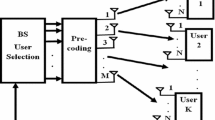Abstract
In this paper, a novel zero-forcing beamforming (ZFBF) is presented for the two-user multiple input single output broadcast channel. Based on the knowledge of channel correlations at the transmitter side, a nonlinear optimization problem is formulated to determine the beamformers so that the weighted ergodic sum-rate is maximized subject to avoiding multi-user interference and meeting a total power constraint. By factorizing each beamformer, the original complicated problem can be transformed into a simpler one. Numerical results show that the performance gap between the proposed ZFBF and the traditional instantaneous channel state information based ZFBF is within 1.5 bits per transmission.


Similar content being viewed by others
References
Bennatan, A., Burshtein, D., Caire, G., & Shamai, S. (2006). Superposition coding for side-information channels. IEEE Transactions on Information Theory, 52(5), 1872–1889.
Bertsekas, D. (1995). Nonlinear programming. Belmont, MA: Athena Scientific.
Biglieri, E., Calderbank, R., Constantinides, T., Goldsmith, A., Paulraj, A., & Poor, H. (2007). MIMO wireless communications. Cambridge: Cambridge University Press.
Bjornson, E., Zakhour, R., Gesbert, D., & Ottersten, B. (2010). Cooperative multicell precoding: Rate region characterization and distributed strategies with instantaneous and statistical CSI. IEEE Transactions on Signal Processing, 58(8), 4298–4310.
Caire, G., & Shamai, S. (2003). On the achievable throughput of a multiantenna Gaussian broadcast channel. IEEE Transactions on Information Theory, 49, 1691–1706.
Caire, G., Jindal, N., Kobayashi, M., & Ravindran, N. (2010). Multiuser MIMO achievable rates with downlink training and channel state feedback. IEEE Transactions on Information Theory, 56(6), 2845–2866.
Jeffrey, A., & Zwillinger, D. (2007). Table of integrals, series, and products (7th ed.). Amsterdam: Academic.
Kobayashi, M., & Caire, G. (2006). An iterative water-filling algorithm for maximum weighted sum-rate of Gaussian MIMO-BC. IEEE Journal on Selected Areas in Communications, 24(8), 1640–1646.
Lau, V. K. N., & Kwok, Y. K. (2006). Channel adaptation technologies and cross layer designs for multi-antenna wireless systems. Cambridge: Wiley.
Liang, Y. C., Chin, F. P., & Liu, K. R. (2001). Downlink beamforming for DS-CDMA mobile radio with multimedia services. IEEE Transactions on Communications, 49(7), 1288–1298.
Raghavan, V., Hanly, S. V., & Veeravalli, V. V. (2013). Statistical beamforming on the Grassmann manifold for the two-user broadcast channel. IEEE Transactions on Information Theory, 59(10), 6464–6489.
Salzer, T., & Mottier, D. (2005). On spatial covariance matrices for downlink eigen-beamforming in multi-carrier CDMA. In Proceedings of the IEEE ICASSP’05 (pp. 1133–1136).
Shanechi, M., Porat, R., & Erez, U. (2010). Comparison of practical feedback algorithms for multiuser MIMO. IEEE Transactions on Communications, 58(8), 2436–2447.
Shiu, D. S., Foschini, G. J., Gans, M. J., & Kahn, J. M. (2000). Fading correlation and its effect on the capacity of multi-element antenna systems. IEEE Transactions on Communications, 48, 502–513.
Veeravalli, V. V., Liang, Y., & Sayeed, A. M. (2005). Correlated MIMO Rayleigh fading channels: Capacity, optimal signaling and asymptotics. IEEE Transactions on Information Theory, 51(6), 2058–2072.
Visotsky, E., & Madhow, U. (2001). Space-time transmit precoding with imperfect feedback. IEEE Transactions on Information Theory, 47(6), 2632–2639.
Wang, J., Jin, S., & Gao, X. (2012). Statistical eigenmode-based SDMA for two-user downlink. IEEE Transactions on Signal Processing, 60(10), 5371–5383.
Yu, Y., Petropulu, A. P., & Poor, H. V. (2011). Measurement matrix design for compressive sensing-based MIMO radar. IEEE Transactions on Signal Processing, 59(11), 5338–5352.
Zhou, S., & Giannakis, G. B. (2003). Optimal transmitter eigen-beamforming and space-time block coding based on channel correlations. IEEE Transactions on Information Theory, 49(7), 1673–1690.
Acknowledgements
This work was supported by the National Natural Science Foundation of China under Grant 61431011 and the Ph.D. Programs Foundation of Ministry of Education of China (young scholars) (Grant No. 20120201120020).
Author information
Authors and Affiliations
Corresponding author
Appendix
Appendix
1.1 Proof of Lemma 1
By denoting \(a_{1n}=\gamma \rho \delta _{1n}\), \(Z_{1}\,\triangleq\,\sum ^{n_{1}}_{n=1} a_{1n} \Big |[\tilde{{\mathbf {h}}}^{'}_{i}]_n\Big |^2\) is defined. Because the characteristic function of the PDF of the sum of several independent random variables is the product of their respective characteristic functions, given the PDF of \(z_{1n}\,\triangleq\,a_{1n} \Big |[\tilde{{\mathbf {h}}}^{'}_{i}]_n\Big |^2\)
we have the following one-to-one correspondences:
where \(f(z_{1})\) and \(\varphi (t)\) respectively denote the PDF of \(Z_{1}\) and their characteristic functions. Here
in (a) is calculated according to the partial fraction expansion method. Then with the definition of characteristic function,
is obtained. Thereafter,
where \(\int ^{\infty }_{0}e^{-\mu x} \ln (1+x)dx=-\frac{1}{\mu }e^{\mu }Ei(-\mu )\) in [7] is utilized. Similarly, with the definitions \(a_{2n}=\left( 1-\gamma \right) \rho \delta _{2n}\) and \(A_{2n}=\frac{\prod ^{n_{2}}_{\tilde{n}=1}\frac{1}{a_{2\tilde{n}}}}{\prod ^{n_{2}}_{\tilde{n}\ne n}\big (\frac{1}{a_{2\tilde{n}}}-\frac{1}{a_{2n}}\big )}\), we derive
Thus, combining (15) and (16) leads to (7).
1.2 Proof of Theorem 1
For \(i=1,2\), the \(P_c \times N_t\) matrix \({\mathbf {W}}_{i}\) (\(n_{i}\,\triangleq\,{\text {rank}}({\mathbf {W}}_{i})\)) can be always factorized as (10) where \({\varvec{\Psi }}_{i}\) and \({\mathbf {B}}_{i}\) are respectively \(P_c \times n_{i}\), \(n_{i}\times N_t\) full rank matrices.
Given the factorization of (10), we can prove that
Since we have \({\text {rank}}({\varvec{\Psi }}_{i})={\text {rank}}({\mathbf {B}}_{i})={\text {rank}}({\mathbf {W}}_{i})=n_{i}\), \(P_c\ge n_{1}+n_{2}\) is derived. To lower the implementation complexity, the optimal \(P_c\) should be \(n_{1}+n_{2}\).
Next, if we further restrict \({\varvec{\Psi }}_{i}\)s satisfying \({\varvec{\Psi }}^H_{i}{\varvec{\Psi }}_{i}={\mathbf {I}}_{n_{i}}\), then \({\mathbf {W}}^H_{i}{\mathbf {W}}_{i}={\mathbf {B}}^H_{i}{\mathbf {B}}_{i}\). Thus, \({\text {tr}}({\mathbf {W}}^H_{i}{\mathbf {W}}_{i})={\text {tr}}({\mathbf {B}}^H_{i}{\mathbf {B}}_{i})=1\). Although \({\varvec{\Psi }}^H_{i}{\varvec{\Psi }}_{i}={\mathbf {I}}_{n_{i}}\) imposes another constraint on \({\varvec{\Psi }}_{i}\), the generality does not lose since this kind of factorization always exists. In this way, (8) is finally cast into (9). The proof of Theorem 1 is completed.
Rights and permissions
About this article
Cite this article
Xu, J., Ren, P. Channel Correlation Based Zero-Forcing Beamforming in Two-User MISO Broadcast Channel. Wireless Pers Commun 97, 5841–5851 (2017). https://doi.org/10.1007/s11277-017-4813-z
Published:
Issue Date:
DOI: https://doi.org/10.1007/s11277-017-4813-z




